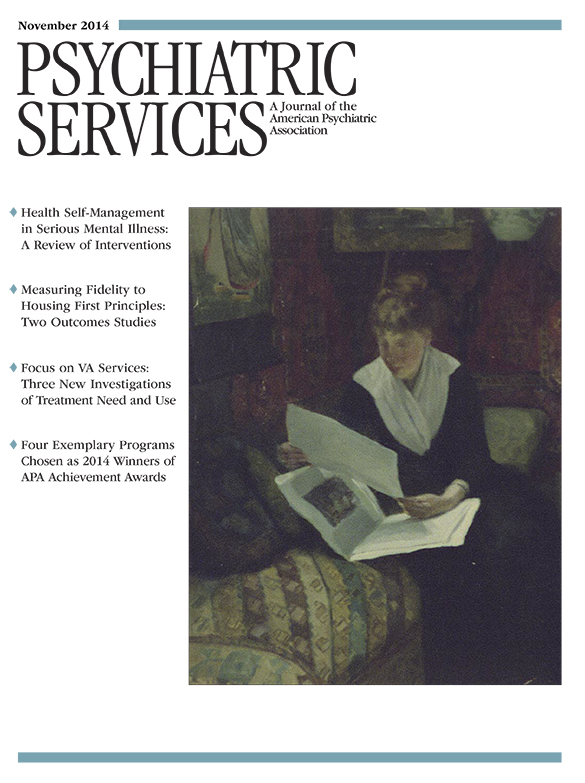CIHS guide to evidence-based fitness interventions for people with serious mental illness: The Center for Integrated Health Solutions (CIHS) has published a 24-page guide designed to help behavioral health administrators, program directors, state agencies, clinicians, practitioners, consumers, and families make informed decisions about evidence-based programs and practices to improve fitness and reduce obesity among people with serious mental illness. The guide provides a detailed overview of nine implementation-ready health promotion practices that have been evaluated in rigorous studies, including key results and other information necessary for assessing whether the practice is appropriate for a particular setting or group. The nine practices described have been implemented in diverse settings. The guide provides contact information for obtaining manuals and other training materials for each of the practices. The guide also includes two checklists—“Evaluating Health Promotion Programs for Persons With Serious Mental Illness: What Works?” and “Evaluating Your Organization’s Readiness to Adopt a Health Promotion Program for Persons With Serious Mental Illness.” The checklists are designed to help organizations consider their needs, compare practices, and assess their resources for change. Among the nine practices described are In SHAPE, Achieving Healthy Lifestyles in Psychiatric Rehabilitation (ACHIEVE), Healthy Eating and Activity in Latinos Treated in the Heights (HEALTH), and Recovering Through Nutrition and Exercise for Weight Loss (RENEW). CIHS is a joint program of the Substance Abuse and Mental Health Services Administration (SAMHSA) and the Health Resources and Services Administration.
Health Promotion Resource Guide: Choosing Evidence-Based Practices for Reducing Obesity and Improving Fitness for People With Serious Mental Illness is available on the CIHS Web site at
www.integration.samhsa.gov/health-wellness/Health_Promotion_Guide.pdf.
Report on past-year disorder prevalence combines two large data sets: A recently released report provides new insight on the scope of specific mental and substance use disorders among U.S. adults (age 18 and older). The report, a joint effort of the SAMHSA and the National Institute of Mental Health, presents analyses of combined 2008–2012 data from SAMHSA’s National Survey on Drug Use and Health and SAMHSA’s Mental Health Surveillance Study (MHSS). The analyses indicate that an estimated 22.5% of adults (51.2 million adults) had at least one of the past-year diagnoses assessed in the MHSS clinical interview; that is, almost a quarter of U.S. adults had one or more mental disorders (including adjustment disorder and substance use disorders). Prevalence rates for specific disorders were as follows: mood disorders, 7.4% (17.0 million adults); anxiety disorders, 5.7% (12.9 million); substance use disorders, 7.8% (17.9 million); and adjustment disorder, 6.9% (16.0 million). An estimated .6% of adults (1.3 million) had at least one of the two measured psychotic symptoms (delusions or hallucinations) in the past year. Overall, prevalence rates of disorders did not differ significantly by gender—22.2% for men and 22.8% for women. However, gender and age differences were evident for specific disorders.
CBHSQ Data Review: Past Year Mental Disorders Among Adults in the United States is available on the SAMHSA Web site at
beta.samhsa.gov/data/sites/default/files/NSDUH-DR-N2MentalDis-2014-1/Web/NSDUH-DR-N2MentalDis-2014.htm.
Mental disorders top AHRQ list of five most costly childhood conditions: Newly released data on medical expenditures in 2011 for the five most costly conditions among U.S. children (ages 0–17) indicate that the highest expenditures were for the care and treatment of mental disorders, followed by asthma, trauma-related disorders, acute bronchitis and upper respiratory infections, and otitis media. The data, which are presented in a new statistical brief from the Agency for Healthcare Research and Quality (AHRQ), indicate that a total of $117.6 billion was spent in 2011 for the medical care and treatment of 5.6 million children. Expenditures to treat mental disorders were $13.8 billion (5.6 million children treated). The mean expenditure per child for children in the mental disorder treatment group ($2,465) was also the highest among the five conditions. About 41.5% of the mental health expenditures were for prescription medicines. Medicaid paid for about half of the amount spent to treat children with mental disorders (48.4%). Expenditures for treating asthma totaled $11.9 billion (12.3 million children; $969 per child). Expenditures for trauma-related disorders totaled $5.8 billion (6.7 million children; $869 per child). Expenditures for acute bronchitis and upper respiratory infections totaled $3.3 billion (11.5 million children; $289 per child). For otitis media, the total was $3.2 billion (7.5 million children; $427 per child). The statistical brief,
The Five Most Costly Children's Conditions, 2011: Estimates for U.S. Civilian Noninstitutionalized Children, Ages 0-17, ummarizes data from the Household Component of the Medical Expenditure Panel Survey and is available on the AHRQ Web site at
meps.ahrq.gov/mepsweb/data_files/publications/st434/stat434.shtml.
Guide on designing care management entities for youths with complex needs: Youths with complex behavioral health needs often receive services from multiple state agencies that do not coordinate services. Lack of coordination may lead to crisis cycles for youths. Care management entities (CMEs) coordinate services from multiple state agencies, ensuring that services are comprehensive and not duplicative, improving outcomes, and lowering costs. AHRQ has published the second implementation guide from the Children's Health Insurance Program Reauthorization Act (CHIPRA) Quality Demonstration Grant Program. The 37-page guide,
Designing Care Management Entities for Youth With Complex Behavioral Health Needs, provides information about the CME design process to states and counties interested in implementing or improving CMEs. The guide draws on experiences of the three states participating in the CHIPRA Quality Demonstration Grant Program, which are using funds to design and implement (Wyoming) or refine and expand (Maryland and Georgia) CMEs. The guide summarizes data from semiannual progress reports and information gathered during two semistructured interviews (2012 and 2014) with state demonstration program staff, CME staff, and representatives from child-serving agencies and family advocacy groups. Findings indicate that CMEs are a promising model for serving high-cost, high-need youths. However, some states need to build capacity for CME design by, for example, facilitating high-level support for CMEs, fostering interagency collaboration, engaging stakeholders, and developing data analysis capabilities. As the guide notes, careful planning is needed because many CME features are linked, and decisions about one component influence options available for others. AHRQ is leading the national evaluation of the CHIPRA Quality Demonstration Grant Program. The new guide is available on the AHRQ Web site at
www.ahrq.gov/policymakers/chipra/demoeval/what-we-learned/implementation-guides/implementation-guide2/impguide2.pdf.
Case studies detail care integration strategies in four states: In response to concerns over the poor quality of general medical care for individuals with behavioral health disorders, states and communities are using a variety of strategies to better coordinate care. One approach is to integrate behavioral and general medical benefits within Medicaid managed care arrangements. Another is to take advantage of enhanced primary care case management programs, which offer financial incentives for primary care providers to coordinate care and function as medical homes. In addition, some communities are reorganizing delivery systems to place general medical providers in behavioral health care settings. A new report compiled by Mathematica Policy Research summarizes findings from ongoing integration programs in Louisiana, North Carolina, Tennessee, and Vermont. Each state program harnesses different funding streams and uses different strategies to organize and deliver care, reflecting the unique environment in which it was developed. Despite the differences, some features are common to all four states. An important component, as described in the report, is to connect individuals with an array of state- and community-funded social services. Information systems are critical for sharing data and monitoring quality. Some programs provide an electronic health record (EHR) platform or encourage providers to use EHRs and other information technologies, such as Web portals and registries, to share patient information, coordinate care, and inform clinical decision making. The 87-page report, which was prepared under a contract to Mathematica from the Office of the Assistant Secretary for Planning and Evaluation (ASPE), U.S. Department of Health and Human Services, is available on the ASPE Web site at
aspe.hhs.gov/daltcp/reports/2014/4CaseStud.pdf.
IOM discussion paper promotes shared decision making in routine practice: A new discussion paper from the Institute of Medicine (IOM) traces the first use of the term “shared decision making” in relation to health care to the 1982 President’s Commission for the Study of Ethical Problems in Medicine and Biomedical and Behavioral Research, which urged adoption of this approach as a means to reform physician-patient communication and to improve implementation of meaningful informed consent to medical treatments. More than 30 years later, the paper notes, the promise of shared decision making remains elusive. The purpose of the 54-page IOM paper,
Shared Decision-Making Strategies for Best Care: Patient Decision Aids, is to stimulate action toward embedding shared decision making—“the pinnacle of patient-centered care”—into clinical practice. It focuses on the need to ensure the quality, integrity, and availability of patient decision aids, along with the deployment of skill sets, attitudes, infrastructure, policies, and systems that support truly shared treatment decisions. The report reviews research on use of shared decision making and patient decision aids, federal legislation and state actions supporting this approach, and guidelines issued by medical professional associations. The authors address the question of how to assess the quality of decision aids, such as by use of a national certification process. The discussion paper is a product of participants in the IOM’s Evidence Communication Innovation Collaborative and is available on the IOM Web site at
www.iom.edu/∼/media/Files/Perspectives-Files/2014/Discussion-Papers/SDMforBestCare.pdf.
National Council updates Mental Health First Aid Toolkit: In 2008, the National Council for Behavioral Health, the Maryland Department of Health and Mental Hygiene, and the Missouri Department of Mental Health brought the concept “mental health first aid” to the United States, with the ten-year goal of making mental health first aid training as common as CPR training. Mental health first aid is a public education program delivered by trained teachers that is designed to help individuals in the community understand mental illnesses, support timely intervention, and save lives. In 2013, the National Council released the first State Legislative Toolkit, designed to help advocates get the attention of state policy makers and other community stakeholders to promote legislation and other state-level effort to implement mental health first aid. In the 2013–2014 legislative session, 21 states passed legislation or initiated executive actions related to mental health first aid, including appropriations for teacher training. On the basis of feedback from toolkit users, a legislative scan, a survey of National Council members, and in-depth interviews with selected experts and advocates to assess progress and document successful strategies, the National Council has issued the Mental Health First Aid State Policy Toolkit for 2014. It includes sample language for legislation; examples of executive actions; talking points, fact sheets, and other informational resources; sample op-ed and other media resources; and strategies for success in planning and carrying out a campaign. The 2014 toolkit is available on the National Council Web site at
www.thenationalcouncil.org/wp-content/uploads/2014/08/Policy-Toolkit-FINAL.pdf.

